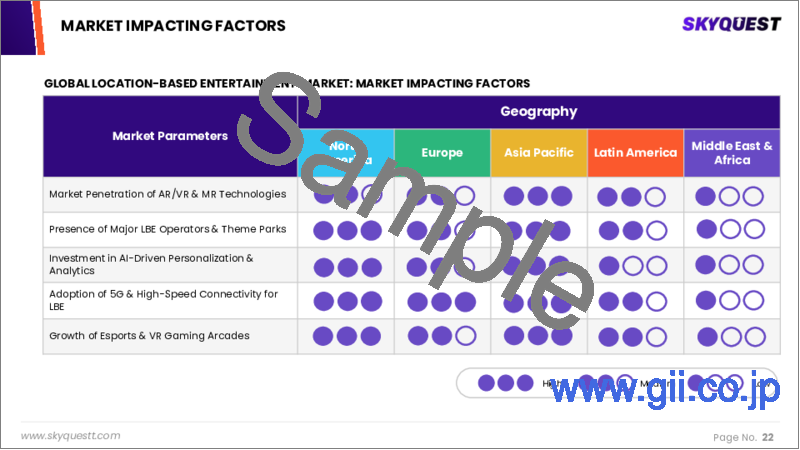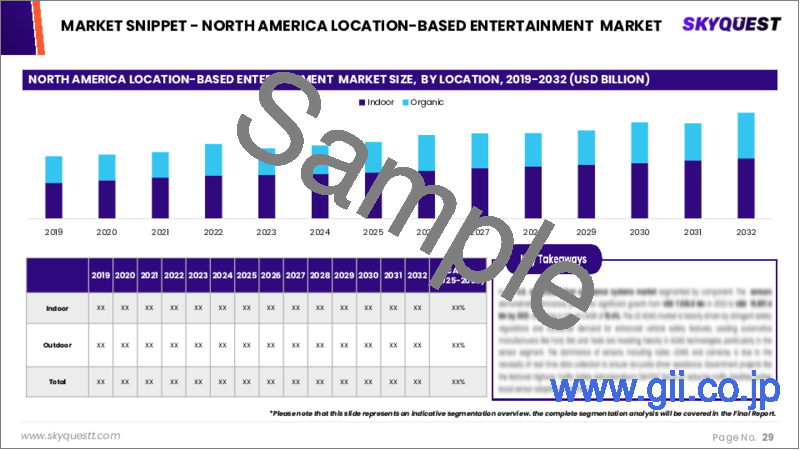|
|
市場調査レポート
商品コード
1622453
ロケーションベースエンターテインメントの市場規模、シェア、成長分析、技術別、提供別、会場別、地域別 - 産業予測、2025~2032年Location-Based Entertainment Market Size, Share, Growth Analysis, By Technology (Virtual Reality, Augmented Reality), By Offering (Hardware, Software), By Venue, By Region - Industry Forecast 2025-2032 |
||||||
|
|||||||
| ロケーションベースエンターテインメントの市場規模、シェア、成長分析、技術別、提供別、会場別、地域別 - 産業予測、2025~2032年 |
|
出版日: 2024年12月22日
発行: SkyQuest
ページ情報: 英文 276 Pages
納期: 3~5営業日
|
全表示
- 概要
- 目次
ロケーションベースエンターテインメントの世界市場規模は、2023年に32億米ドルと評価され、2024年の40億8,000万米ドルから2032年には284億9,000万米ドルに成長し、予測期間中(2025年~2032年)のCAGRは27.5%で成長する見通しです。
ゲーム業界は、仮想現実(VR)の台頭により変革期を迎えており、プレイヤーに成長に不可欠な没入体験を提供しています。市場開拓のため、ゲーム開発会社はVRやロケーションベースエンターテインメント(LBE)プロバイダーとの合併を進めています。特に、2021年2月のVertigo GamesによるSpringboard VRの買収は、LBE機能を強化し、オペレーターに幅広いVRコンテンツライブラリへのアクセスを提供することを目的としています。LBE市場は増加傾向にあり、ARや3Dアニメーションのような没入型技術を活用して、アーケードやVRカフェのような場所で魅力的な体験を生み出しています。さらに、Koch Media GmbHが2021年9月にVertigo Gamesを買収したことは、特にCOVID-19の流行がもたらす課題に照らして、この分野における世界ネットワークの拡大傾向を示しています。
目次
イントロダクション
- 調査の目的
- 調査範囲
- 定義
調査手法
- 情報調達
- 二次データと一次データの方法
- 市場規模予測
- 市場の前提条件と制限
エグゼクティブサマリー
- 世界市場の見通し
- 供給と需要の動向分析
- セグメント別機会分析
市場力学と見通し
- 市場概要
- 市場規模
- 市場力学
- 促進要因と機会
- 抑制要因と課題
- ポーターの分析
主な市場の考察
- 重要成功要因
- 競合の程度
- 主な投資機会
- 市場エコシステム
- 市場の魅力指数(2024年)
- PESTEL分析
- マクロ経済指標
- バリューチェーン分析
- 価格分析
- ケーススタディ分析
- 顧客と購買基準の分析
ロケーションベースエンターテインメント市場規模:技術別
- 市場概要
- バーチャルリアリティ
- 拡張現実
- プロジェクションマッピング
- その他のテクノロジー
ロケーションベースエンターテインメント市場規模:提供別
- 市場概要
- ハードウェア
- ソフトウェア
- サービス
- プロフェッショナルサービス
- コンサルティング
- サポートとメンテナンス
- トレーニングと展開
- マネージドサービス
ロケーションベースエンターテインメント市場規模:会場別
- 市場概要
- 遊園地
- テーマパーク
- アーケード
- その他の会場
ロケーションベースエンターテインメント市場規模
- 北米
- 米国
- カナダ
- 欧州
- ドイツ
- スペイン
- フランス
- 英国
- イタリア
- その他欧州地域
- アジア太平洋地域
- 中国
- インド
- 日本
- 韓国
- その他アジア太平洋地域
- ラテンアメリカ
- ブラジル
- その他ラテンアメリカ地域
- 中東・アフリカ
- GCC諸国
- 南アフリカ
- その他中東・アフリカ
競合情報
- 上位5社の比較
- 主要企業の市場ポジショニング(2024年)
- 主な市場企業が採用した戦略
- 市場の最近の動向
- 企業の市場シェア分析(2024年)
- 主要企業の企業プロファイル
- 会社概要
- 製品ポートフォリオ分析
- セグメント別シェア分析
- 収益の前年比比較(2022-2024)
主要企業プロファイル
- Microsoft
- Meta
- Unity Technologies
- Nvidia
- Sony Interactive Entertainment
- Samsung
- Barco Electronic Systems
- Panasonic
- Huawei Technologies
- HQ Software
- HTC Vive
- Niantic Inc.
- Vicon Motion Systems
- OptiTrack
- SpringboardVR
- 4Experience
- Hologate
- Ultraleap
- Magic Leap
結論と推奨事項
Global Location-Based Entertainment Market size was valued at USD 3.2 billion in 2023 and is poised to grow from USD 4.08 billion in 2024 to USD 28.49 billion by 2032, growing at a CAGR of 27.5% during the forecast period (2025-2032).
The gaming industry is experiencing a transformative shift with the rise of virtual reality (VR), offering players immersive experiences crucial for growth. In an effort to capture greater market share, video game developers are merging with VR and location-based entertainment (LBE) providers. Notably, Vertigo Games' acquisition of Springboard VR in February 2021 aimed to enhance LBE capabilities and provide operators access to a broader VR content library. The LBE market is on the rise, leveraging immersive technologies like AR and 3D animation to create engaging experiences in venues such as arcades and VR cafes. Additionally, Koch Media GmbH's acquisition of Vertigo Games in September 2021 demonstrates the trend of expanding global networks within this sector, particularly in light of challenges presented by the COVID-19 pandemic.
Top-down and bottom-up approaches were used to estimate and validate the size of the Global Location-Based Entertainment market and to estimate the size of various other dependent submarkets. The research methodology used to estimate the market size includes the following details: The key players in the market were identified through secondary research, and their market shares in the respective regions were determined through primary and secondary research. This entire procedure includes the study of the annual and financial reports of the top market players and extensive interviews for key insights from industry leaders such as CEOs, VPs, directors, and marketing executives. All percentage shares split, and breakdowns were determined using secondary sources and verified through Primary sources. All possible parameters that affect the markets covered in this research study have been accounted for, viewed in extensive detail, verified through primary research, and analyzed to get the final quantitative and qualitative data.
Global Location-Based Entertainment Market Segmental Analysis
Global Location-Based Entertainment Market is segmented by technology, offering, venue and region. Based on technology, the market is segmented into virtual reality, augmented reality, projection mapping and other technologies. Based on offering, the market is segmented into hardware, software and services. Based on venue, the market is segmented into amusement parks, theme parks, arcades and other venues. Based on region, the market is segmented into North America, Europe, Asia Pacific, Latin America and Middle East & Africa.
Driver of the Global Location-Based Entertainment Market
The Global Location-Based Entertainment market is anticipated to grow due to the increasing consumer demand for engaging and immersive video content, video games, and various entertainment experiences. This rising interest is likely to boost the sales of Virtual Reality (VR) headsets, as consumers seek more interactive and personalized options in their leisure activities. Furthermore, the introduction of advanced technologies, such as 360-degree VR, is expected to play a crucial role in enhancing the appeal and accessibility of location-based entertainment offerings. These factors collectively suggest a strong trajectory for market expansion in the coming years.
Restraints in the Global Location-Based Entertainment Market
The Global Location-Based Entertainment market faces several restraints that hinder its growth and potential. Developers of location-based VR experiences grapple with the challenge of designing games that balance entertainment and educational value while understanding their target audience's preferences. Additionally, many independently operated, region-specific VR entertainment establishments, along with those in a decentralized framework, often neglect to prioritize technological advancements and quality improvements. This shortfall adversely impacts consumer retention and reduces foot traffic, ultimately limiting the market's ability to expand and attract a wider audience. Addressing these issues is crucial for enhancing the overall experience and sustainability of location-based entertainment venues.
Market Trends of the Global Location-Based Entertainment Market
The Global Location-Based Entertainment market is experiencing a dynamic shift driven by the "triple revolution" of social media, the Internet, and mobile devices, which are redefining family entertainment centers. As competition intensifies, facility operators are adapting their game offerings to cater to evolving consumer preferences, with a significant emphasis on virtual reality (VR) and augmented reality (AR) experiences. This trend is being fueled by innovative game developers focused on integrating cutting-edge technologies to create immersive gaming environments. As a result, there is a growing demand for sophisticated entertainment options, propelling the market toward a more interactive and digitally enriched landscape.
Table of Contents
Introduction
- Objectives of the Study
- Scope of the Report
- Definitions
Research Methodology
- Information Procurement
- Secondary & Primary Data Methods
- Market Size Estimation
- Market Assumptions & Limitations
Executive Summary
- Global Market Outlook
- Supply & Demand Trend Analysis
- Segmental Opportunity Analysis
Market Dynamics & Outlook
- Market Overview
- Market Size
- Market Dynamics
- Drivers & Opportunities
- Restraints & Challenges
- Porters Analysis
- Competitive rivalry
- Threat of substitute
- Bargaining power of buyers
- Threat of new entrants
- Bargaining power of suppliers
Key Market Insights
- Key Success Factors
- Degree of Competition
- Top Investment Pockets
- Market Ecosystem
- Market Attractiveness Index, 2024
- PESTEL Analysis
- Macro-Economic Indicators
- Value Chain Analysis
- Pricing Analysis
- Case Study Analysis
- Customer & Buying Criteria Analysis
Global Location-Based Entertainment Market Size by Technology & CAGR (2025-2032)
- Market Overview
- Virtual Reality
- Augmented Reality
- Projection Mapping
- Other Technologies
Global Location-Based Entertainment Market Size by Offering & CAGR (2025-2032)
- Market Overview
- Hardware
- Software
- Services
- Professional Services
- Consulting
- Support And Maintenance
- Training And Deployment
- Managed Services
Global Location-Based Entertainment Market Size by Venue & CAGR (2025-2032)
- Market Overview
- Amusement Parks
- Theme Parks
- Arcades
- Other Venues
Global Location-Based Entertainment Market Size & CAGR (2025-2032)
- North America (Technology, Offering, Venue)
- US
- Canada
- Europe (Technology, Offering, Venue)
- Germany
- Spain
- France
- UK
- Italy
- Rest of Europe
- Asia Pacific (Technology, Offering, Venue)
- China
- India
- Japan
- South Korea
- Rest of Asia-Pacific
- Latin America (Technology, Offering, Venue)
- Brazil
- Rest of Latin America
- Middle East & Africa (Technology, Offering, Venue)
- GCC Countries
- South Africa
- Rest of Middle East & Africa
Competitive Intelligence
- Top 5 Player Comparison
- Market Positioning of Key Players, 2024
- Strategies Adopted by Key Market Players
- Recent Developments in the Market
- Company Market Share Analysis, 2024
- Company Profiles of All Key Players
- Company Details
- Product Portfolio Analysis
- Company's Segmental Share Analysis
- Revenue Y-O-Y Comparison (2022-2024)
Key Company Profiles
- Microsoft
- Company Overview
- Business Segment Overview
- Financial Updates
- Key Developments
- Google
- Company Overview
- Business Segment Overview
- Financial Updates
- Key Developments
- Meta
- Company Overview
- Business Segment Overview
- Financial Updates
- Key Developments
- Unity Technologies
- Company Overview
- Business Segment Overview
- Financial Updates
- Key Developments
- Nvidia
- Company Overview
- Business Segment Overview
- Financial Updates
- Key Developments
- Sony Interactive Entertainment
- Company Overview
- Business Segment Overview
- Financial Updates
- Key Developments
- Samsung
- Company Overview
- Business Segment Overview
- Financial Updates
- Key Developments
- Barco Electronic Systems
- Company Overview
- Business Segment Overview
- Financial Updates
- Key Developments
- Panasonic
- Company Overview
- Business Segment Overview
- Financial Updates
- Key Developments
- Huawei Technologies
- Company Overview
- Business Segment Overview
- Financial Updates
- Key Developments
- HQ Software
- Company Overview
- Business Segment Overview
- Financial Updates
- Key Developments
- HTC Vive
- Company Overview
- Business Segment Overview
- Financial Updates
- Key Developments
- Niantic Inc.
- Company Overview
- Business Segment Overview
- Financial Updates
- Key Developments
- Vicon Motion Systems
- Company Overview
- Business Segment Overview
- Financial Updates
- Key Developments
- OptiTrack
- Company Overview
- Business Segment Overview
- Financial Updates
- Key Developments
- SpringboardVR
- Company Overview
- Business Segment Overview
- Financial Updates
- Key Developments
- 4Experience
- Company Overview
- Business Segment Overview
- Financial Updates
- Key Developments
- Hologate
- Company Overview
- Business Segment Overview
- Financial Updates
- Key Developments
- Ultraleap
- Company Overview
- Business Segment Overview
- Financial Updates
- Key Developments
- Magic Leap
- Company Overview
- Business Segment Overview
- Financial Updates
- Key Developments





